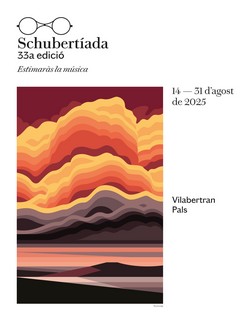Second week of the series in collaboration with the Master's Degree of Lied-ESMUC.Elías Juan Ongay presents Die Lotoblume, from Myrten; the performers of the song are Hermann Prey and Leonard Hokanson. Thank you very much, Elías Juan!

The cycle of songs "Myrthen" Op. 25 of Robert Schumann was composed in the prolific year of 1840, and with a very special motive: it was a wedding gift for his wife Clara Wieck with whom finally, after a problematic trial against Clara´s father who opposed her relationship, could get married that year.
As I said, 1840 was a year of extensive production for Schumann, it´s incredible to tell that his great cycles of Lieder "Liederkreis" Op. 39, "Frauenliebe und Leben" Op. 42 and "Dichterliebe" Op. 48 were also composed in that single year.
In most cases he uses only one poet for each cycle: Joseph von Eichendorff is the poet of Liederkreis" Op. 39, Adalbert von Chamisso of "Frauenliebe und Leben" Op. 42 and Heinrich Heine of "Dichterliebe" Op. 48, but as I was saying, the conception of "Myrthen" is different, it was inspired and specially dedicated to Clara, it seems that Schumann wanted to tell her his personal vision of his love for her, portraying the nature of man and woman and their relationship between them. For that aim, he uses more than one poet: Goethe, Rückert, Th. Moore, Heine, Burns, Byron and J. Mosen adapting the choice of poems to their self-expression.
Eric Sams in his book "The songs of Robert Schumann" ventures that if someone looks for what are the subconscious impulses that led Schumann to choose each song and its context in the cycle, "Die Lotosblume" (The Lotus Flower) and "Du bist wie eine blume "(You are like a flower), both of Heinrich Heine, would be the product of the enormous love, close to the adoration, that Robert had for Clara.
Speaking about the poet, Heinrich Heine, the poem "Die Lotosblume" is part of his "Lyrysche Intermezzo" poems that seems to reflect the love story he had with his cousin with who maintained an intense romance even after she married that developed in the same years in which he writes these poems.
This idea of a secret meeting of the lovers in the night appears clearly in the poem of "Die Lotosblume".
Die Lotusblume ängstigt
Sich vor der Sonne Pracht
Und mit gesenktem Haupte
Erwartet sie träumend die Nacht.
Der Mond, der ist ihr Buhle
Er weckt sie mit seinem Licht,
Und ihm entschleiert sie freundlich
Ihr frommes Blumengesicht,
Sie blüht und glüht und leuchtet
Und starret stumm in die Höh';
Sie duftet und weinet und zittert
Vor Liebe und Liebesweh.
The Lotus-flower trembles
Before the sun's gold light;
And, with her head low drooping,
Waits, dreamily, the night.
The Moon, he is her lover,
He wakes her with his light,
And unto him reveals she
Her flower-face so bright.
She blooms and glows and brightens,
And dumbly looks above;
She weeps and sighs and trembles
With love and the woes of love.
(translation by Emma Lazarus)
Musically Schumann provides the poem with a constant and soft mattress of quarters note that reflect a static drowsiness and provide an expectation to the story of the love meeting between the Lotus flower and the moon (in truth a male moon, because for Germans this noun is masculine and the noun flower is feminine), because she waits for her arrival during the day until when that happens she unfolds, opens and shows her expected lover and then perfumes, cries and trembles. All this moment (Sie blüht unf glüht und leuchtet, und starret stumm in die Höh, Sie dustet und weinet und zittert) is intensified with an accelerando and crescendo until the arrival to the word “zittert” (trembles) in what is a magnificent poetic and musical expression of the most intimate and passionate encounter that one can imagine between two lovers who only have that moment, the night to consummate their love.
However, the Lotus flower trembles not only of love, also of sorrows of love. If we go back to the love story of Heine and her cousin, which was most of the time clandestine, we can give us a better idea of what it was to this passionate lovers those limited moments to see each other and live with complete disinhibition their most visceral feelings as well as their frustration of the impossibility that this relationship and this mutual love be socially accepted.
In this last aspect, we could say that the love story of Robert and Clara finally has its deserved redemption when they manage to get married in 1840.














Comments powered by CComment